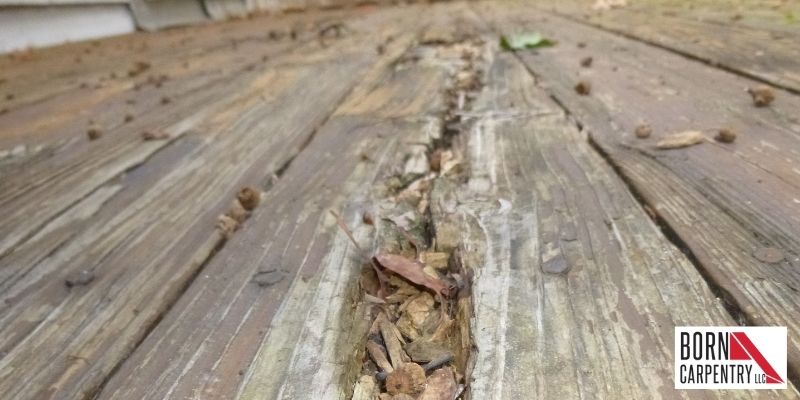Your deck is subjected to some of the most extreme weather, right? From extreme cold and buckets of snow in the winter to intense heat in the summer and a lot of rain in the spring and fall, your deck will have to deal with it all. All this weathering can impact your deck’s health and structure, leaving it to appear a little worn.
How do you know if your deck is merely becoming older or if it’s time to repair it, given that every deck tends to take a beating?
Signs That Indicate That Your Deck Needs to Be Replaced

Below are some of the signs you’ll observe indicating that it’s time to replace your deck…
1. Significant, Noticeable Damage

All forms of building materials wear and tear with time. From missing screws to cracks, some deck issues can be easily repaired, while others will require a complete replacement. You’ll need a new deck if you see substantial damage, such as split boards, large holes, termite signs, or other problems.
2. Loose Railings
Railings that are loose are not always a sign that your deck has to be replaced completely. They are, nevertheless, a serious safety concern that must be addressed. If the wobbly railings are coupled with other issues, it may be time to replace the deck. If your railings are unsecured, you should secure them as soon as possible.
3. Unsecure or Bowing Boards
Unsecured or lifted boards can pose a safety danger that cause people to trip, and you, as the homeowner, may be held liable. If you walk across your deck and discover wobbly boards, you may need to replace them.
With time, joists can become loose and detach from the ledger board. Boards may become loose and move as a result of this. Pest damage, water damage, or rot can also weaken the decking, causing the boards to start bowing.
4. Questionable Posts
What holds up your deck are the posts. The posts bear a lot of weight, making their structural integrity critical to the deck’s stability. You may have an issue if you discover big cracks or rot damage in the posts. If water is accumulating around the base of the posts, see an expert to determine the best approach for diverting water away from them.
5. Wood Rot
Rotting wood in your deck is a major problem. Wood rot moves very fast and spreads from one location to another. It makes your deck’s structure weak and causes it to deteriorate over time. It’s time to replace the deck when you observe a lot of rot.
A little wood rot that is left unchecked will ultimately require you to invest in a completely new deck. Once you notice wood rot, respond quickly to prevent it from spreading. If the problem is isolated, remove and replace the affected wood. The deck should then be thoroughly cleaned and sealed with a high-quality wood deck sealant.
You’ll be better off rebuilding the whole deck and starting over if the wood rot has spread significantly. To avoid further wood rot, ask your contractor for advice on how to care for your deck.
6. Rusted or Missing Hardware
You will find hardware and fittings on the underside of your deck. Take the time to inspect the base of your deck to ensure that none of the fittings are missing, loose, deteriorated, or covered in dust. This is more likely to happen as your deck becomes older. However, decks of all ages can face these issues.
7. Deteriorating Ledger Board
What connects your deck to the side of your house and holds it in place is the ledger board. Your entire deck is jeopardized if your ledger board is compromised. If you observe loose fittings or decay appearing on your ledger board, seek professional advice immediately.
Also, make sure the flashing around your ledger board is tightly fastened, as this will help to prevent water damage and rot from destroying the board.
8. Mold and Mildew
Mold will inevitably grow on your deck as a result of the moisture it is exposed to. A small amount of greenish mold is largely an eyesore, but if you notice mushroom-like mold or fungal growths, you could be dealing with more significant harm. Remove mold immediately and use a stain that includes a fungicide to treat the wood to prevent future problems.
9. Cracking Deck Boards
When you find your deck’s boards cracking and splitting, it’s time to fix them. These splinters aren’t only hard on the feet, but they are also a warning that your decking is failing. Many older wood decks experience this as a natural aging process.
Wood expands and contracts in response to changes in temperature and humidity. This leads to cracks as the wood becomes older and dries out. If you haven’t sealed or stained your deck in a while, you are also going to notice cracks.
If just a few deck boards are cracked, you can replace them. However, if the cracks are all over the surface, you need to start considering repairs or possibly replacement.
10. Age
No material used for the building of a home will last indefinitely. Age will always be a factor that influences the need to replace a deck. Your deck will also be affected by weather and climate.
The lifespan of a typical wood deck might range from 15 to 40 years. However, the quality of routine maintenance carried out and the materials used determine longevity. If your deck is over 20-years-old and exhibiting symptoms of wear, you should start thinking about replacing it.
Conclusion
If your deck has a lot of damage, don’t risk keeping the old structure. The collapse of a deck might result in serious injuries. Employ the services of a competent deck builder to construct a new deck that will provide you with years of worry-free enjoyment. Born Carpentry can assess your current deck and build you a new one if needed.




